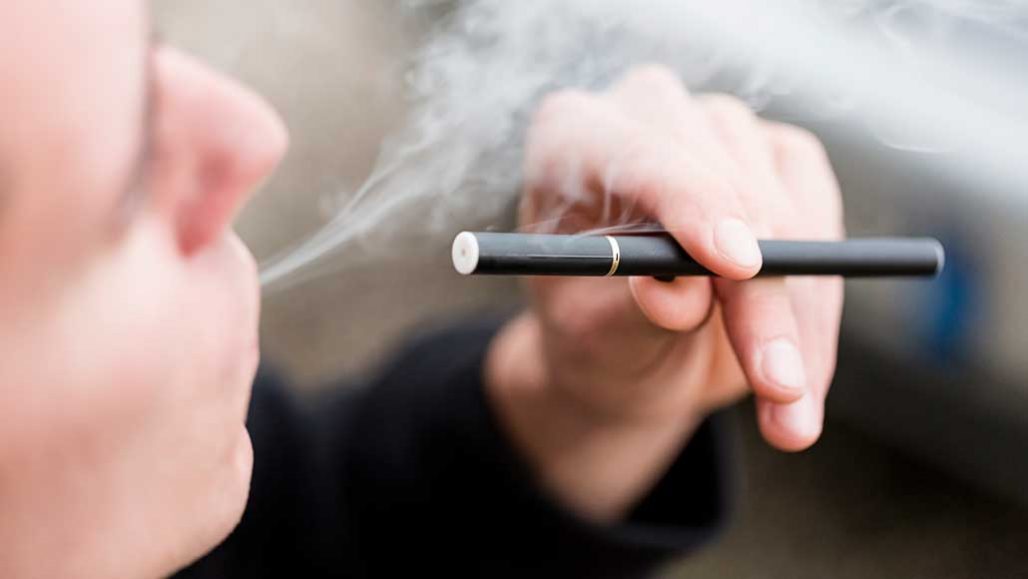Vaping may have landed eight teens in the hospital
E-cigarette use was the common factor among the teens

Chemicals inhaled while using e-cigarettes can damage the lungs, studies have found. The devices may be why eight teens recently landed in a Wisconsin hospital with serious respiratory illnesses.
mauro_grigollo/iStock /Getty Images Plus
Eight Wisconsin teens were so short of breath that they were hospitalized this summer. The cause of their lung injuries hasn’t yet been determined. And they lived in different places. But the teens had one thing in common: e-cigarettes. All eight reported vaping in the weeks and months before their hospital stays.
“Some of these kids were quite ill and needed a lot of support,” says Jonathan Meiman. He’s a chief medical officer with the Wisconsin Department of Health Services in Madison. Some of the teens even needed to use ventilators to help them breathe, he says.
The health department’s investigation into these cases has just begun. But vaping as a culprit isn’t a stretch. More adolescents are using JUUL and other types of electronic cigarettes, sometimes frequently. So “it is not surprising” to see some children developing lung injuries, says Sharon McGrath-Morrow. As a pediatric pulmonologist, she specializes in kids’ breathing and lung issues. She works at Johns Hopkins University School of Medicine in Baltimore, Md.
“Studies already have reported more chronic respiratory symptoms and more severe asthma symptoms in adolescents who vape,” says McGrath-Morrow.
One study in 2017 included more than 2,000 Southern California 11th- and 12th-graders. The researchers looked at symptoms such as ongoing cough, congestion or wheezing, or developing bronchitis. Teens who had used e-cigarettes had about twice the risk of such symptoms compared with teens who hadn’t used the products.
The Wisconsin teens reported serious flu-like symptoms. Those included fever, difficulty breathing and nausea. Their shortness of breath got worse over days or weeks, Meiman says. Each teen finally had to go to the hospital. The teens came from three different counties in southeastern Wisconsin. All were patients at Children’s Hospital of Wisconsin in Milwaukee, which alerted the state.
Laura Crotty Alexander is a pulmonologist. She sees adult patients at the University of California San Diego School of Medicine. She and her colleagues have seen multiple cases of unexplained lung disease in the last several years. “And the only thing we can tie it to is their vaping habits,” she says.
Bad breath
The lung injuries Crotty Alexander has seen are linked to too much inflammation. The lungs fill with inflammatory cells. That makes the person short of breath and unable to get enough oxygen. Those inflammatory cells are responding to changes in the lungs that are likely caused by vaping. “The lungs don’t like it when you breathe in high concentrations of chemicals that they’re not used to,” she says.
Vaping is a multi-chemical assault on the lungs. First, there’s nicotine. This addictive substance appears to damage the respiratory system. “Nicotine by itself can impair the ability of lung cells to clear mucus and foreign particles from the lungs,” McGrath-Morrow says. And that can lead to chronic respiratory symptoms.
And there’s potential harm from the flavoring ingredients in e-liquids. E-liquids come in more than 7,000 flavors. And those flavors have not been tested to see if they are safe when inhaled. Heating the flavors to turn them into vapor can change what’s in them, McGrath-Morrow says. It produces chemicals that can be toxic and may cause cancer.
Finally, there is the liquid itself. The two main solvents in e-liquids are propylene glycol (PROH-puh-leen GLY-cahl) and glycerin (GLIH-sur-in). They hold the flavor and other chemicals. When heated, both also add toxicity to the plume that hits the lungs.
From 2017 to 2018, e-cigarette use reported by teens rose from 11.7 percent to 20.8 percent, government data show. That’s a 78 percent rise nationwide. This is a whole generation of adolescents who likely wouldn’t have used traditional cigarettes, researchers say. But now they are now getting introduced — and potentially addicted — to nicotine through vaping.
E-cigarettes are still relatively new. So the long-term consequences of vaping for the lungs aren’t known. But any health damages will emerge more and more as kids who vape grow older. “I am concerned that these children will develop chronic respiratory symptoms and impaired lung health,” McGrath-Morrow says. These problems may not occur in everyone, she says. “But there is no way to predict who is susceptible to the harmful effects of these products.”
The investigation of the Wisconsin teens could aid research on these questions. Health officials are seeking more details about the teens’ e-cigarette use. These likely include the types of devices, e-liquids or flavors the teens used, and how much they vaped. Such answers “would be very helpful in trying to understand what’s going on and who else might be at risk,” Crotty Alexander says.







